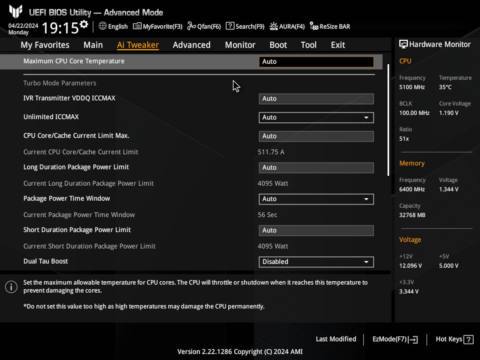You might recall reports of Unreal-based games crashing when running on gaming PCs using high-end Intel processors toward the start of this year. As the problem was getting flagged up around the world, things were serious enough for Intel to investigate the problem formally. That's still ongoing but Intel has made an early statement on the matter, in which it's essentially blaming motherboard manufacturers for having default settings in the BIOS/UEFI that allow the CPU to run well past the recommended limits for power and current.
The full statement was relayed by Igor's Lab but the most telling part is this comment by Intel: “600/700 Series chipset boards often set BIOS defaults to disable thermal and power delivery safeguards designed to limit processor exposure to sustained periods of high voltage and frequency.”
Anyone who bought an Intel-based motherboard in the last few years will probably already be aware of this. For example, by default, Asus enables its Multi Core Enhancement feature in the BIOS which simply sets the power and current limits to their maximum possible values.
Intel's CPUs have two primary power limits, PL1 and PL2, and the idea behind them is that the former is the maximum power the chip can consume under 'normal' circumstances, whereas the latter allows for more energy to be used, for a limited duration.
Take the Core i9 13900K. That has a PL1 and PL2 of 125 and 253 W respectively, but stick that into most Asus 600/700 series motherboards with MCE enabled, and the processor is given limits of 4095 W. The same is true for the current—the chip is permitted to draw well over Intel's recommended maximum value of 307 A. It's over 100 A more than the 'extreme config' limit of 400 A.

That particular CPU won't ever use that much power, but for the 13th and 14th Gen i9 models, the excessively high power and current limits—along with overly high operating voltages—all result in a processor being unstable in demanding scenarios, such as playing games. And it's not just Asus that does this; ASRock, Gigabyte, MSI, and others all have BIOS defaults that ignore Intel's recommended limits.
Asus responded to the reports by releasing a new BIOS for most of its Intel 600/700 series motherboard chipsets, and that includes an 'Intel Baseline Profile' that forces the PL2 and current limits to the recommended values. However, it still sets the PL1 higher than what it should be. That's not a problem for most Intel CPUs, provided they have a decent cooler on them, but it's an example of Intel saying one thing and a motherboard vendor doing something different.
Intel's datasheets for its 13th and 14th Generation Core processors do clearly show what the maximum limits for everything are, and contain statements such as “long term reliability cannot be assured in conditions above or below Maximum/Minimum functional limits.” If the end user wants to push their hardware beyond these, then that's absolutely fine, but it should never be the case that one's motherboard defaults to such a scenario.
So, is this all a case of Intel being the victim of motherboard vendors seemingly doing whatever they like? No, not really.
Motherboard manufacturers have been setting BIOS default values for Intel processors well outside the recommended values for a good while now and I can't imagine that Intel is unaware of this. In fact, there's just no way it could miss this as every time the chip giant has released a new CPU, the marketing material always contains benchmarks comparing the new chip to previous models, or ones by AMD, that have been carried out on a test PC using a motherboard by Asus, ASRock, MSI, etc—it even has a dedicated webpage for “Truth and Transparency” that clearly shows what motherboard the tests were done with.
Even if Intel forced its power and current limits before commencing the testing, it would have clearly seen what the motherboard's BIOS was defaulting to before changing anything.
In other words, Intel has known about this for long enough and has been happy to enjoy the fruits of such settings, i.e. chart-topping performance figures. But now, with customers and retailers complaining about games crashing and chips completely failing, it would seem that Intel is trying to point the finger at motherboard vendors. The reality is both are to blame here.

Best CPU for gaming: The top chips from Intel and AMD.
Best gaming motherboard: The right boards.
Best graphics card: Your perfect pixel-pusher awaits.
Best SSD for gaming: Get into the game ahead of the rest.
What needs to happen is that every Intel-based motherboard has a BIOS/UEFI that defaults to Intel's current, power, and voltage limits—not some version of them, but the exact values, across the board. The ability to alter them should only be accessible via an optional menu that clearly warns the user about the potential dangers of changing them.
At the moment, what we're getting are BIOS updates that, in some cases, only do this as an option one has to hunt for to enable.
As we review new motherboards, we'll keep an eye out for what the various limits are in the default BIOS to see if vendors are onboard with keeping your hardware safe or if they're still pushing the limits to garner those few extra points on the performance charts.






